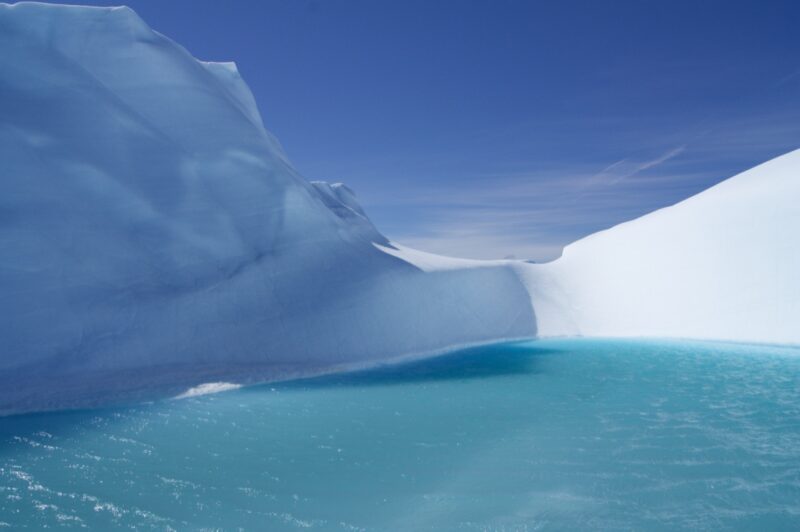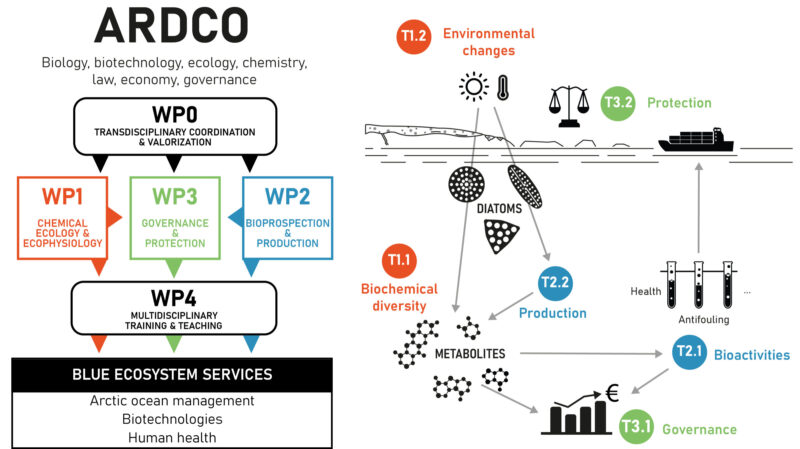ARDCO

The ARDCO flagship project focuses on ARctic Diatom microalgae bioactive Chemodiversity : prOspection,
prOduction and prOtection
Main Coordinators: Johann Lavaud (LEMAR, CNRS) et Betty Queffelec (AMURE, UBO)
Diatoms support numerous essential AO ecosystem services including the production of essential metabolites which significance extends to human health and blue biotechnology applications in Nordic countries and beyond. However, climate change is threatening these services, with the possibility of losing bioactive metabolites.
Up to now, environmental Law solutions are not adapted to protect microorganisms, including diatoms, since biodiversity Law mainly focuses on vertebrates. Additionally, the exploitation of this natural resource raises questions about its conservation and sustainable management in a complex framework of actual States sovereignty and jurisdiction, and indigenous people rights over their ancestral territory. Finally, beyond its exploitation and protection, the bio-chemo-diversity of arctic diatoms and microorganisms is increasingly acknowledged as a potentially strong leverage for the implementation of legal regulations to protect their habitats, especially sea-ice, and the AO.
To preserve this diversity, interdisciplinary approaches are needed to develop legal strategies based on scientific knowledge of the impacts of climate change.

The ARDCO project has the following 3 objectives:
- Prospection: to determine arctic diatom essential metabolites and bioactivities
- Production: how their synthesis is impacted by the new AO environmental features and how abiotic parameters could be used to enhance their synthesis
- Protection: to propose legal and policy strategies to protect arctic diatom bio-chemo-diversity and beyond
This project’s positioning relative to other recent and on-going arctic research initiatives is unique and complementary in analyzing current policy, proposing innovative environmental Law approaches and policy assessments on the conservation of microorganisms, and the broad bioprospection of diatom metabolites for health and blue biotechnology purposes.
The expected outcomes include a better understanding and management of the Arctic Ocean, addressing the issues of conservation and sustainable use of diatoms, including indigenous property rights. It also involves analysing the strategies of economic players and examining the role of environmental law in the face of the disappearance of the habitat of a key element of the ecosystem, diatoms.
They will also reveal crucial applications with potential strong socio-economic value for Arctic states and beyond, including human health for new nutraceuticals and blue biotechnologies for the development of ecologically inspired anti-fouling agents applicable to cold waters.

General view of the ARDCO project structure including the disciplines, pluridisciplinary work-packages
(WP) and the main outreaches (left panel), and work-packages (WP) articulation with their main scientific targets
shown as Tasks (T) (right panel).
ISblue Partnerships:
- UBO-IUEM:
- LEMAR (J. Lavaud, C. Hellio, S. Connan, B. Moriceau, M. Fauchon, M. Gallinari, G. Delebecq, S. Madec) ;
- AMURE (B. Queffelec, A. Choquet, E. Quillérou, J. Richard);
- UBO-Faculty of Medecine: GGFB (T. Montier, T. Le Gall);
- UBS: LBCM (N. Bourgougnon, A.-S. Burlot).
External partnerships:
- France :
– IFREMER Nantes (E. Nicolau, T. Lacour);
– Concarneau Marine Station (C. Hubas); - Italy: ZSN/Zoological Station A. Dohrn, Naples (C. Brunet, C. Sansone);
- Germany: Kiel Univ. (N. Matz-Lück);
- Norway: SINTEF Ocean, Trondheim (C. Volpe, M. Nymark);
- Canada: IRL Takuvik-CNRS/Laval Univ., Québec (M. Babin, R. Amiraux); Dalhousie Univ., Halifax (A. Chircop).
 Attention, vous utilisez un navigateur peu sûr !
Attention, vous utilisez un navigateur peu sûr !